Nestled high within the majestic Himalayas, Nepal has long captivated imaginations as a land of mystery, rich history, and ancient legends. For years, its relative isolation only amplified its allure for intrepid travelers. Some even believe that Nepal’s Kathmandu Valley served as the blueprint for the mythical paradise of “Shangri-La” in James Hilton’s renowned 1933 novel, Lost Horizon. Today, Kathmandu is widely recognized as the vibrant capital of Nepal, officially known as the Federal Democratic Republic of Nepal, but the name also encompasses the sprawling expanse within its distinctive bowl-shaped valley.
Unraveling the Meaning of Kathmandu
The name “Kathmandu” is believed to have originated from the Pahari people, who constitute a significant portion of the region’s population. It is almost certainly derived from the iconic Kasthamandap Temple, a remarkable three-tiered pagoda that once graced the city’s Durbar Square. In Sanskrit, “kastha” translates to “wood,” and “mandap” refers to a covered shelter or pavilion. Interestingly, “Kasthamandap” is still used as an alternative name for the city in some Buddhist texts, highlighting the temple’s deep social and historical significance. Legend has it that the Kasthamandap Temple was constructed in the 16th century, but archaeological discoveries suggest that the site’s original structure may date back as far as the 7th century. Tragically, this historical landmark collapsed during the devastating 2015 earthquake. However, there is hope for its restoration to its former splendor.
Locating Kathmandu: Gateway to the Himalayas
Kathmandu, a bustling metropolitan city, is situated within the Kathmandu Valley in the Central District of Nepal. Nepal itself is a mountainous nation bordering Tibet and India, straddling the towering Himalayas. Mount Everest, the world’s highest peak, lies approximately 100 km to the east and slightly north of Kathmandu. This region is often considered the gateway to the Himalayas, welcoming adventurers and spiritual seekers alike. Kathmandu sits at a significant elevation of about 1,400 meters (4,600 feet).
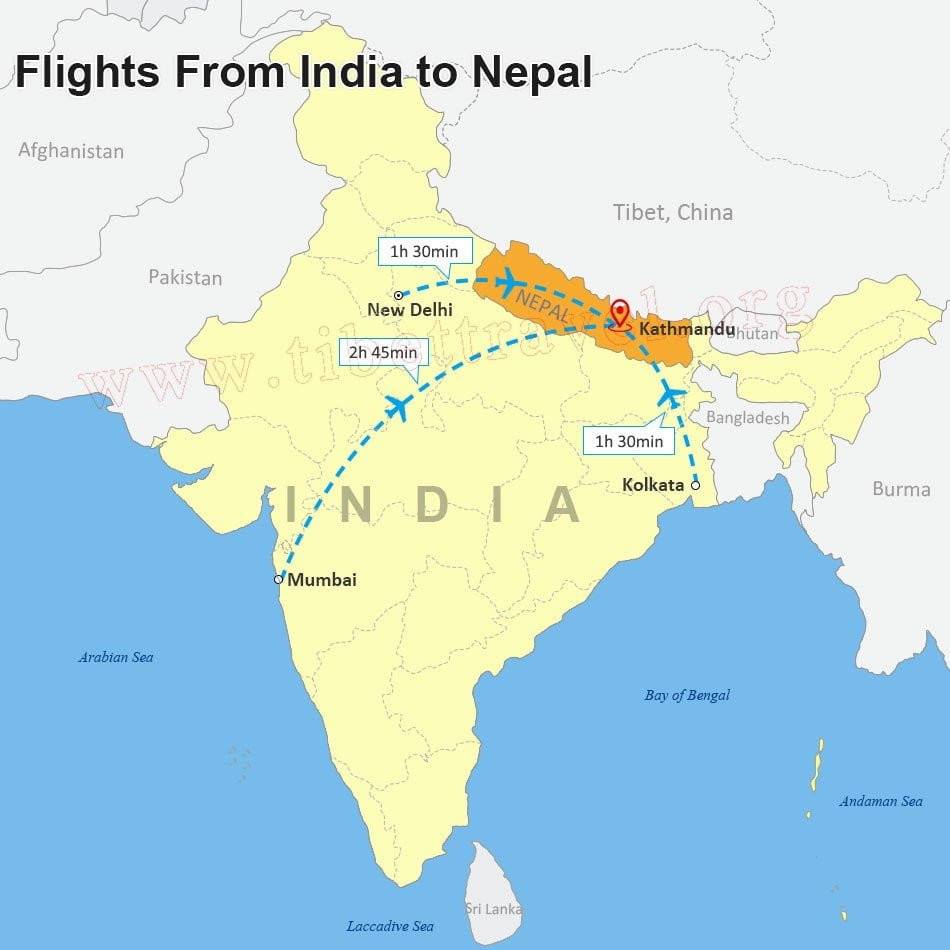 Where is Kathmandu, Nepal located on the map?
Where is Kathmandu, Nepal located on the map?
Kathmandu’s Climate: A Pleasant Surprise
Kathmandu’s climate may surprise visitors expecting extreme temperatures due to its altitude and inland location. Officially, the city and most of the Kathmandu Valley enjoy a “warm temperate” climate. While altitude and topography create regional variations, summer temperatures generally average a comfortable 28 to 30 degrees Celsius (82 to 86 degrees Fahrenheit). Winter temperatures hover around 10 degrees Celsius (50 degrees Fahrenheit), occasionally dipping below freezing. Rainfall also varies locally, averaging around 1.4 meters (55 inches) annually. The majority of precipitation occurs during the monsoon season, from June to August, with minimal rainfall during the winter months.
Time in Kathmandu: Nepal Time Zone
Kathmandu operates within the Asia/Kathmandu time zone, identified by the IANA. This time zone is commonly known as Nepal Time (NPT), which is UTC + 5:45. This unique time difference reflects Nepal’s distinct geographical position.
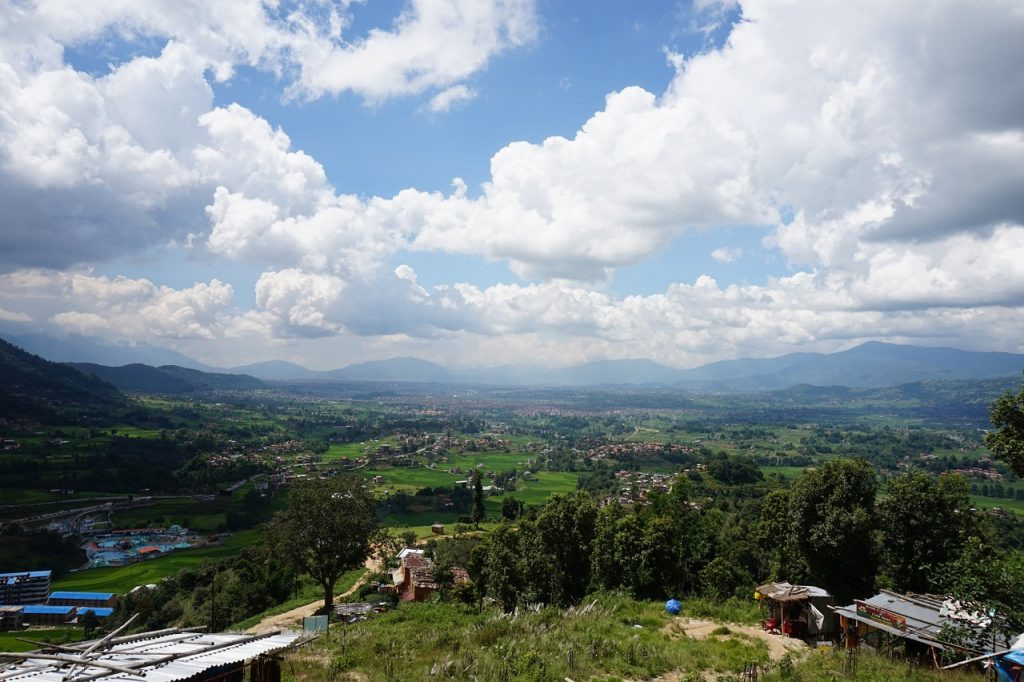 Panoramic view of the Kathmandu Valley in Nepal
Panoramic view of the Kathmandu Valley in Nepal
Kathmandu Airport: Tribhuvan International Airport (KTM)
Kathmandu is served by Tribhuvan International Airport (KTM), its own international airport. KTM manages 9 scheduled domestic routes within Nepal and 35 scheduled international routes, connecting Kathmandu to various parts of the world. The airport features a single runway capable of accommodating all aircraft types and sizes, including night landings. Direct flights are readily available from major international hubs like Delhi, Kuala Lumpur, Dubai, and Seoul, making Kathmandu accessible to global travelers.
Exploring the Kathmandu Valley: A Cradle of Civilization
The Kathmandu Valley is a sprawling and vibrant region encompassing the metropolitan city of Kathmandu and several other significant cities and towns, including Patan, Bhaktapur, Madhyapur Thimi, Kirtipur, and Lalitpur. The suffix “pur” simply means “place” in Sanskrit. Numerous smaller villages also dot the valley. The total population of the Kathmandu Valley is estimated to be around 5 million. Geologically, the valley is a bowl-shaped basin, the site of an ancient lakebed. The land is remarkably fertile, and combined with favorable weather patterns, it’s ideal for agriculture. This rich environment likely drew early settlers and contributed to the valley’s development as a population center.
The Kathmandu Valley boasts a long history of human habitation, likely spanning thousands of years. Despite its apparent isolation, the valley has historically welcomed visitors and traders from across the globe. Kathmandu flourished as a vital trading post along the Silk Road, facilitating east-west commerce. The city was strategically positioned on a branch of the main route, as traders journeyed between Tibet and India. Beyond goods, these interactions introduced diverse cultures and religions. Modern Kathmandu is renowned for its multi-ethnic character, fostering an atmosphere of respect and tolerance. Hinduism is the predominant religion, practiced by approximately 70% of the population, followed by Buddhism at 20%, with other faiths making up the remaining 10%.
Kathmandu Architecture: A Living Museum
Kathmandu attracts adventurous tourists, many drawn by the breathtaking mountain scenery and rich cultural tapestry. Some seek spiritual enlightenment, while others are captivated by the sheer abundance of ancient monuments, palaces, and temples. Kathmandu is where art and religion converge, manifesting in magnificent architectural forms. Recognizing the global significance of these ancient sites, UNESCO has designated seven Monument Zones within the valley as World Heritage Sites.
 Durbar Square in Kathmandu, Nepal showcasing ancient palaces and temples
Durbar Square in Kathmandu, Nepal showcasing ancient palaces and temples
Kathmandu’s architectural treasures extend far beyond these UNESCO zones, which are essentially large areas encompassing numerous national treasures. Some zones are known as “Durbar Squares,” meaning “Place of Palaces.” Others feature significant Hindu Temples or Buddhist Stupas (dome-shaped religious monuments). Kathmandu’s Durbar Square, also known as Hanuman Dhoka, houses fifty temples within two quadrangles. Similar Durbar Squares are located in the neighboring towns of Bhaktapur and Patan.
Some Hindu temples in Kathmandu are remarkably ancient, such as the Changu Narayan Temple, dating back to the 4th century, and the pagoda-style Pashupatinath Temple, with origins in the 5th century. Buddhist stupas, with their distinctive dome shapes, are also prominent. Boudhanath Stupa is one of the largest in the world and earned UNESCO World Heritage Site status in 1979. Swayambhu Stupa, another highly revered site for both Buddhists and Hindus, features Buddha’s eyes painted on its superstructure, gazing in four directions. Swayambhu is also popularly known as the Monkey Temple due to its resident monkey population.
 The iconic Buddhist Stupa Swayambhu, also known as the Monkey Temple, in Kathmandu
The iconic Buddhist Stupa Swayambhu, also known as the Monkey Temple, in Kathmandu
The 2015 earthquake inflicted damage on many of Kathmandu’s architectural treasures, with some buildings completely destroyed. The Nepalese government has committed to rebuilding these sites, a monumental undertaking expected to take many years before Durbar Square and other areas are fully restored. However, it’s important to note that many buildings survived, and while visitors may witness ongoing restoration work, the area’s essential character remains intact. While the official Nepal tourism website may downplay the earthquake’s impact, focusing on the resilience of Kathmandu, the following is a list of buildings known to have been completely destroyed in the 2015 earthquake, highlighting the scale of the reconstruction effort:
- Kasthmandap
- Maju Dega and Narayan Vishnu Temples
- Trailokya Mohan
- Krishna (Chasin Dega)
- Dharahara (Bhimsen Tower)
- Hari Shankar
- Jagan Narayan
- Vatsala Durga Temple
- Fasidega Temple
Numerous other buildings sustained damage but are considered repairable.
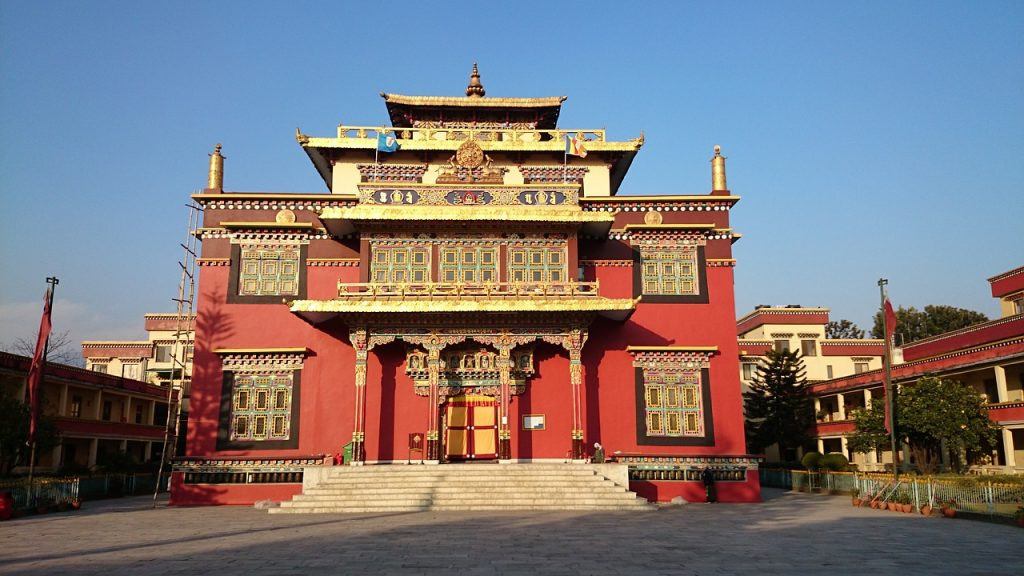 Shechen Tennyi Dargyeling Monastery in Kathmandu, Nepal, showcasing intricate architecture
Shechen Tennyi Dargyeling Monastery in Kathmandu, Nepal, showcasing intricate architecture
Is Kathmandu a Safe City for Travelers?
Despite being a densely populated city, Kathmandu is remarkably safe for travelers in terms of personal crime. It is considered one of the safest urban destinations globally, with locals known for their welcoming nature. The traditional motto, “Atithi Devo Bhava,” meaning “Guest is equivalent to God,” reflects the deep-seated respect and hospitality extended to visitors in Kathmandu.
Regarding health, travelers should ensure their vaccinations are up to date and avoid drinking untreated tap water. Air pollution can be a concern in some areas, particularly for those with respiratory conditions. Earthquake risk is another factor to consider in this seismically active region. While tremors are common, major earthquakes are relatively infrequent. Prior to the 2015 earthquake, a similar magnitude event occurred in 1934. During earthquakes, injuries are often caused by falling debris or landslides, so it’s wise to avoid potentially hazardous locations and be aware of building evacuation routes.
Language and Currency in Kathmandu
Kathmandu is a truly cosmopolitan city with a diverse linguistic landscape. Nepali is the most widely spoken language, but English is also widely understood, especially in tourist areas. The official currency is the Nepalese Rupee (NPR). It can be challenging to obtain NPR outside of Nepal, but currency exchange services are available at the airport. However, better exchange rates are often found within the city. It’s advisable to exchange only a small amount at the airport for initial expenses like taxis and meals and conduct larger exchanges later in Kathmandu. US dollars are sometimes accepted for small transactions and tips, making it useful to carry some US currency.
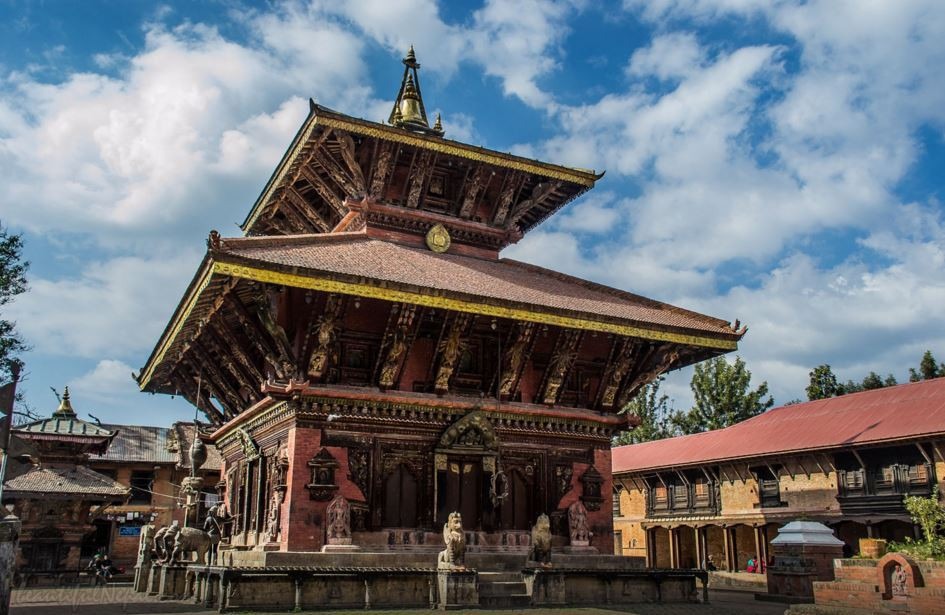 The ancient Changu Narayan Temple near Kathmandu, Nepal, a UNESCO World Heritage Site
The ancient Changu Narayan Temple near Kathmandu, Nepal, a UNESCO World Heritage Site
Visiting Kathmandu: A Unique Travel Experience
Tourism in Kathmandu began to flourish in the 1950s, building upon its long history as a destination for traders and pilgrims from Hindu and Buddhist faiths worldwide. During the 1960s and 70s, Kathmandu became a popular stop for the hippie trail and independent travelers. Today, it’s a firmly established destination for mainstream tourists, offering a range of accommodations from budget-friendly options to luxury hotels like the Hyatt Regency, Hotel Radisson, The Everest Hotel, Hotel De L’Annapurna, and Hotel Yak and Yeti, some of which even feature casinos. Popular tourist areas include Freak Street (officially Jhochhen Tol), Thamel, and Jhamel (Jhamsikhel), offering a variety of shops, hotels, and restaurants. Bargaining is common practice in Kathmandu markets, and prices for tourists are often inflated, so haggling is expected.
Things to Do in Kathmandu: Culture, Festivals, and Crafts
Kathmandu is a vibrant and bustling city with constant activity. Visiting during one of its numerous festivals offers a particularly enriching experience. Most festivals are deeply rooted in religious traditions, dating back centuries, providing a glimpse into Nepal’s rich cultural heritage. With 133 different festivals annually, there’s a high chance of witnessing one of these remarkable spectacles. A more recent addition to the festival calendar is the Kathmandu Jazz Festival (Jazzmandu), established in 2002, showcasing the influence of Western music.
 A performance at Jazzmandu, the Kathmandu Jazz Festival
A performance at Jazzmandu, the Kathmandu Jazz Festival
Kathmandu is also renowned for its traditional crafts and artistry. Visitors can find unique handcrafted goods and even participate in workshops to learn traditional skills. Kathmandu is considered the origin of the pagoda-style architecture, predating its adoption in China, highlighting its significant contribution to global architectural history. However, what truly makes Kathmandu special is its people, known for their genuine friendliness. A simple “Namaste,” accompanied by a gesture of pressed palms, is often enough to create an instant connection with a Kathmanduite, reflecting the deep respect and warmth inherent in Nepali culture. This Sanskrit greeting, meaning “The divine in me bows to the divine in you,” encapsulates the spirit of hospitality in this extraordinary city.
The 2015 Kathmandu Earthquake: Resilience and Rebuilding
On April 25, 2015, a powerful 7.8 magnitude earthquake struck the region, one of the most devastating earthquakes ever recorded in Nepal. Numerous aftershocks followed, including a significant 7.3 magnitude earthquake on May 12. These earthquakes resulted in tragic loss of life and widespread structural damage. Many people lost their homes, and the country continues to recover from this catastrophe. Media coverage at the time often focused on scenes of devastation, leading some to believe that Kathmandu was completely flattened. However, most of Kathmandu remained relatively unaffected. Today, Kathmandu is largely recovered, with daily life continuing.
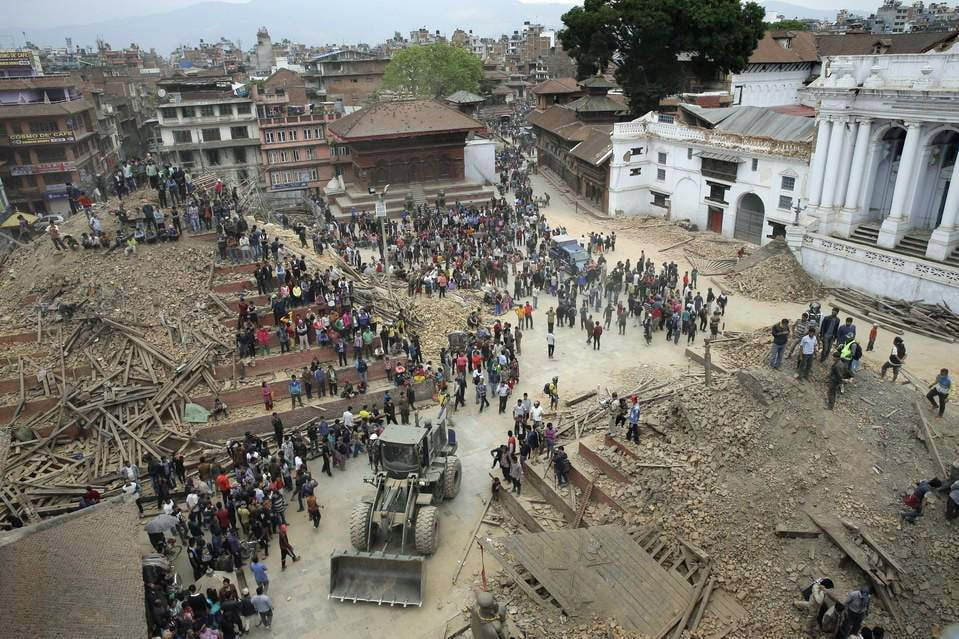 The aftermath of the devastating 2015 earthquake in Kathmandu, Nepal
The aftermath of the devastating 2015 earthquake in Kathmandu, Nepal
Why Kathmandu is Earthquake Prone: Tectonic Activity
Kathmandu’s location in a mountainous region makes it susceptible to earthquakes due to ongoing tectonic activity. The region lies at the convergence of two major tectonic plates: the Indian section of the Indo-Australian plate and the Eurasian plate. The Indian plate is subducting, or pushing beneath, the Eurasian plate at a rate of 4-5 cm per year. This continuous collision and upward pressure contribute to the formation of the Himalayas, with the mountain range increasing in height by approximately 1 cm annually. This tectonic dynamism is the fundamental cause of the frequent earthquakes in the region.
Kathmandu is a captivating destination, a city of contrasts that appeals to the mind, heart, and spirit. While modern in many ways, it offers visitors a unique opportunity to step back in time, experiencing a world where history is woven into the fabric of everyday life. Kathmandu truly embodies the essence of a real-world Shangri-La.

